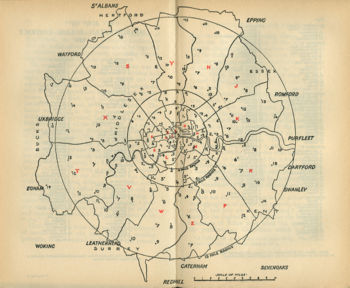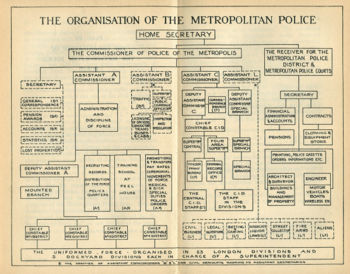Scotland Yard: Difference between revisions
imported>Russell Potter (→Organizational Structure: slight copyedit) |
imported>Russell Potter m (→References: typo) |
||
| Line 27: | Line 27: | ||
==References== | ==References== | ||
*''The Official Encyclopedia of Scotland Yard'', by Martin Fido and Keith Skinner (London: Virgin Books, 1999) | *''The Official Encyclopedia of Scotland Yard'', by Martin Fido and Keith Skinner (London: Virgin Books, 1999) | ||
*''The Scotland Yard Files: | *''The Scotland Yard Files: Milestones oin Crime Detection'', by Alan Moss and Keith Skinner (London: National Archives, 2007) ISBN 19033365880 | ||
[[Category:CZ Live]] | [[Category:CZ Live]] | ||
[[Category:History Workgroup]] | [[Category:History Workgroup]] | ||
[[Category:Law Workgroup]] | [[Category:Law Workgroup]] | ||
Revision as of 22:34, 28 April 2007
Scotland Yard is the traditional name of the headquarters of the London Metropolitan Police. The name derives from a small, enclosed field in the Whitehall district of London, which was adjacent to the force's original headquarters. The name has remained through subsequent moves, first in 1890 to "New" Scotland Yard, an ornate brick building in the Italian Revival style designed by Norman Shaw on the Victoria Embankment, and then in 1967 to the present New Scotland Yard on Victoria Street in Westminster. Because the original Detective Division of the Metropolitan Police had its offices in the rear of Whitehall Place in the first of these buildings, the name has been especially associated with the department's detective branch, known since 1878 as the Criminal Investigation Department or CID, but the phrase "Scotland Yard" has also been applied to the Metropolitan Police as a whole.
History
Scotland Yard was founded as the headquarters of the Metropolitan Police by Sir Robert Peel. It opened on 29 September 1829, housing the two commissioners and their administrative staffs. It was not (and has never been) a police station in the usual sense, since each division of the police operates its own local stations, but has housed certain centralized units, such as the CID and theSpecial Branch, which operate with a degree of independence in their specialized areas.
Metropolitan Police District and Divisions
It is not widely realized outside of Britain, but the one area that the Metropolitan Police District has always excluded is the City of London, which has its own entirely separate police force. The original district was divided further into seventeen divisions, each represented by a letter of the alphabet, as follows: A - Westminster; B - Chelsea; C - Mayfair and Soho; D - Marylebone; E - Holborn; F - Kensington; G - Kings Cross; H - Stepney; K - West Ham; L - Lambeth; M - Southwark; N - Islington; P - Peckham; R - Greenwich; S - Hampstead; T - Hammersmith and V - Wandsworth. Three new divisions were added in 1865: W - Clapham; X - Willesden and Y - Holloway, and lastly J Division (Bethnal Green) was created in 1886, for a total of twenty-one divisions until Z Division (Croydon) was added in 1921. The Thames River Police had no divisional letter, but the entirety of the Thames was its "beat". The diagram at right indicates all the division boundaries as they stood in 1929, with numbered indications for each Police Station.
This system of lettered divisions was maintained until 1985, when the Newman Restructuring Plan replaced them with a system of 67 divisions and subdivisions, which was further refined to 62 divisions in 1995. The entire divisional system, however, was abandoned in 1999 when it was replaced by the Borough Policing model.
Organizational Structure
From their inception, the Metropolitan Police have been under the authority of the Home Secretary, a cabinet-level ministry of the British Government. Reporting to the Secretary was the Commissioner of Police for the Metropolis, a position originally shared by two men, but since the mid-nineteenth century held by one. At a parallel level of authority, the Receiver for the Metropolitan Police Districts had charge of all actuarial business and accounts for the police, as well as the management of all buildings and property. Under the Commissioner, a variety of Assistant Commissioners with differing duties and levels of responsibility have come into, and out of, existence. The longest-lasting arrangement was one with three Assistant Commissioners, known as A, B, and C, with A having charge of administration and discipline, B in charge of traffic and public carriage, and C in charge of criminal matters. It is this last position, commonly referred to within the force as the "ACC," which had the most serious and wide-ranging duties; under this position were the superintendants of the Criminal Investigation Division, the Special Branch, and the Area Superintendants, who oversaw CID officers in the various divisions. The rest of the (uniformed) force was placed, somewhat oddly, under a Deputy to Assistant Commisioner "A". The chart at right shows the organization structure in this classic era, as it stood in 1929.
Notable Figures Associated with Scotland Yard
- Inspector Charles Frederick Field
- Howard Vincent, first DCI
- Chief Constable Frederick Porter Wensley
- Chief Inspector Lilian Wyles
See Also
References
- The Official Encyclopedia of Scotland Yard, by Martin Fido and Keith Skinner (London: Virgin Books, 1999)
- The Scotland Yard Files: Milestones oin Crime Detection, by Alan Moss and Keith Skinner (London: National Archives, 2007) ISBN 19033365880


